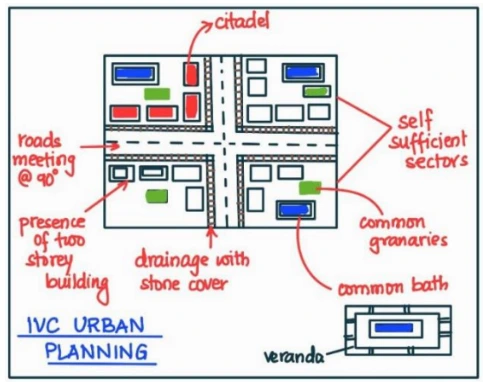Answer:
Approach:
- Introduction: Discuss all three keywords- IRD, disguised employment, and distress migration.
- Body:
- Describe the ways through which IRD helps to solve the issues of disguised unemployment and distress migration.
- Write about the challenges/issues in IRD implementation.
- Provide a way forward.
- Conclusion: Conclude on a positive note.
|
Introduction:
Body:
In India, around 52 crores people face disguised unemployment. The Agricultural sector is the one involving the greatest number of disguised labour force as it contributes only 16-17% in our GDP despite involving the 50% of labour force. Distress migration can be defined as people leave origin for the cities and towns due to negative home conditions like lack of job opportunities, agricultural failure etc.
Integrated rural development (IRD), a multidimensional approach that seeks to promote sustainable and equitable development in rural areas offers a comprehensive solution, addressing both issues in the following manner:
IRD: a resolution towards the predicament of disguised unemployment and distress migration:

- Employment Generation: IRD creates diverse job opportunities, reducing disguised unemployment and discouraging distress migration. IFAD study shows rural development generates up to 4x more jobs than urban-focused investments.
- Skill Development: IRD offers tailored skill development programs, reducing disguised unemployment and the need for distress migration. Ex: PMKVY in India trained 1.5M rural youth in vocational skills, enhancing employability and reducing migration for work.
- Infrastructure Development: IRD improves rural infrastructure, attracting investments, creating jobs, and addressing distress migration factors. World Bank data indicates that enhanced rural infrastructure can increase agricultural productivity by up to 25%, fostering employment opportunities in the sector.
- Access to Credit and Finance: IRD enables credit access, reducing disguised unemployment and distress migration. Grameen Bank’s microfinance initiatives empower rural entrepreneurs with small loans, fostering business start-ups and employment opportunities locally.
- Social Security and Welfare Measures: IRD enhances healthcare, education, and housing, reducing vulnerabilities and distress migration. Improved rural healthcare reduces the need for medical migration, ensuring better access to facilities and addressing inadequate healthcare infrastructure.
Challenges in Integrated Rural Development Implementation:
- Limited Resources: Insufficient funding and resources hinder the implementation of integrated rural development programs. Example- Panchayats receives 95% of their funds from devolved funds, while generating only 5 per cent from own resources.
- Fragmented Approach: Lack of coordination and integration among sectors and stakeholders leads to an ineffective and disjointed approach to rural development.
- Socioeconomic Disparities: Unequal access to resources and opportunities in rural areas exacerbates socioeconomic disparities, necessitating targeted interventions. Example- The incidence of poverty is 21% in rural areas while it is around 5% in urban areas.
- Agricultural Challenges: Low productivity, climate change impacts, and outdated farming practices pose obstacles to rural development in the agricultural sector. Example- An average agricultural household in India earns Rs. 10k per month.
- Inadequate Infrastructure: Insufficient infrastructure, including roads, electricity, healthcare, and education facilities, hampers economic activities and limits development opportunities in rural areas.
Way Forward
- Increased Investment: Allocate more resources for effective rural development and infrastructure. Example- Budget 2023-24 allocates Rs 10 lakh crore for infrastructure Development.
- Coordinated Approach: Foster collaboration among stakeholders for efficient implementation. Example- Gati Shakti platform for multi-sectoral coordination.
- Targeted Interventions: Address the needs of marginalized groups, reducing inequalities in rural areas. Example- Using SECC-2011 data for PM Aawas Yojna (R).
- Sustainable Agriculture Practices: Promote and train farmers in sustainable techniques for improved productivity and livelihoods.
Conclusion:
IRD addresses disguised unemployment and distress migration through employment generation, skill development, infrastructure improvement, access to credit, and social security measures. However, challenges of limited resources, fragmented approach, disparities, agricultural issues, and inadequate infrastructure must be addressed for effective implementation.
To get PDF version, Please click on "Print PDF" button.


https://uploads.disquscdn.com/images/a09b4ab02fdb68c15f5719c58fbd846a53a7addfdbf11038d662948ba44bd634.jpg https://uploads.disquscdn.com/images/77280c2c8d326bcc3f32df89b60156d1c8045f8bdbff54cc0a05a3040e2a4ef8.jpg
https://uploads.disquscdn.com/images/b190845423dd75897bdce874c7e9b202a0b6a24b6c5f9bb4f4b9dba448172c73.jpg https://uploads.disquscdn.com/images/9324b70beded5905ba356fe8c77452e5df4d0a86bd8f2be4297729d0080ceaca.jpg
Thanks
https://uploads.disquscdn.com/images/70d4357a97ed5955c273b3cea7787cf834fa7895e3602d0ffd5053e56c2702cb.jpg https://uploads.disquscdn.com/images/74a53f060e7841a1512f9627b6b2cea6feff3a398a72969cd00f5f176b146f1f.jpg